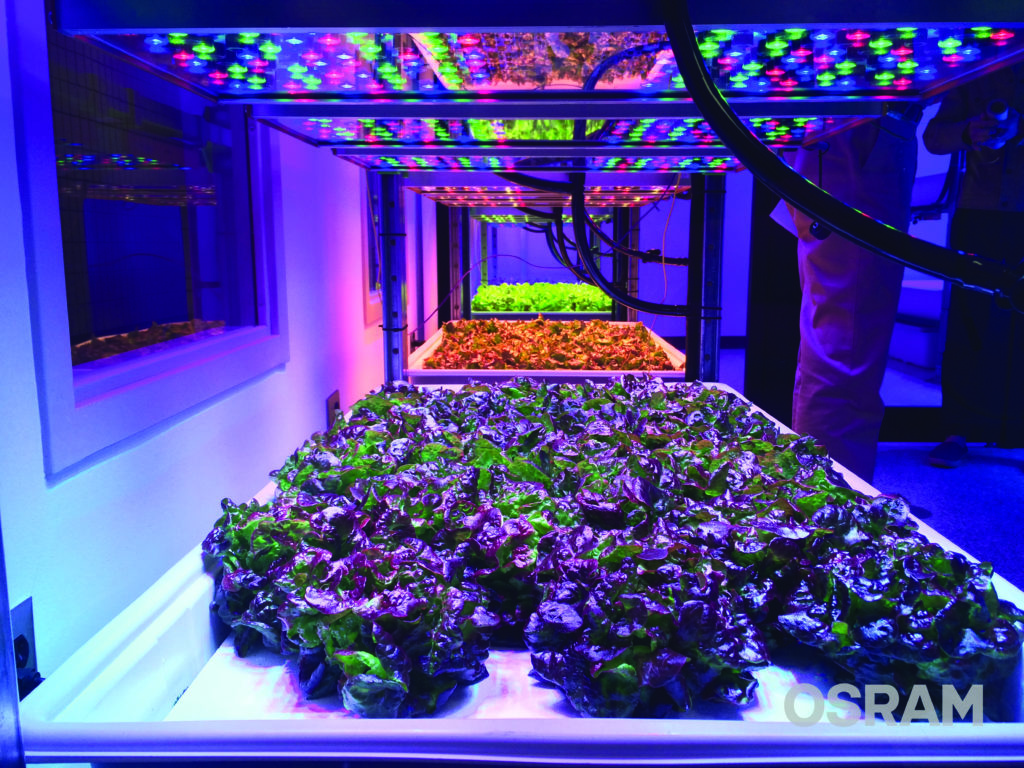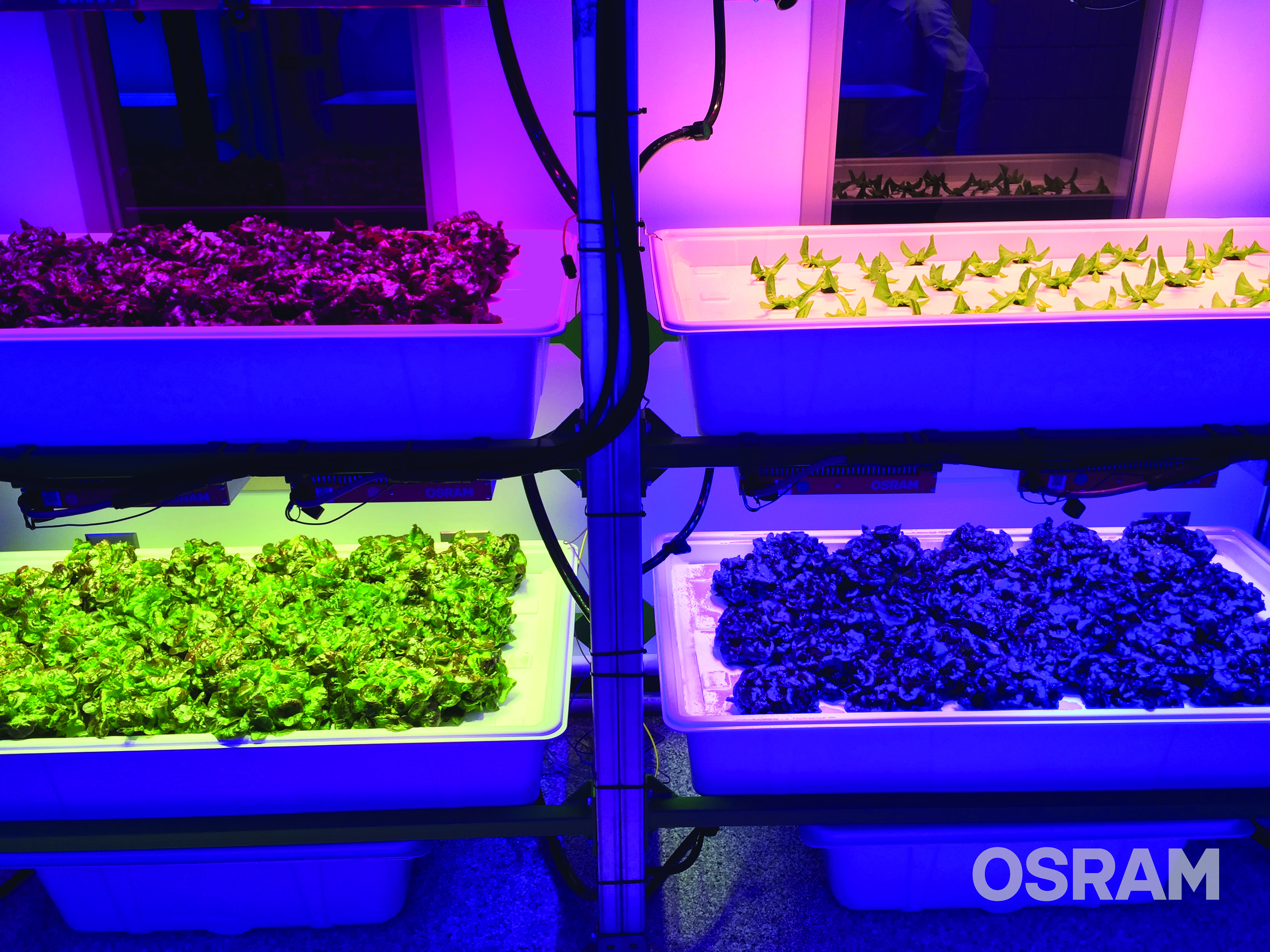

Oct 18, 2018LED lights module enables CEA experimentation
An indoor window from a common area at Michigan State University (MSU) gives students and campus visitors a glimpse into the advancing technology of vertical farming and controlled environment agriculture.
The window shows research being conducted by Michigan State University Professor and Floriculture Extension Specialist Erik Runkle with doctorate degree candidate William Meng. The Controlled- Environment Lighting Laboratory, also called CELL, is used to research the effects of different light spectra on vegetable characteristics such as taste, tenderness and color as well as agronomic traits.
“We’re hoping to be bringing the concept to their attention,” Runkle said. “We want our research to be a little more transparent than I think what typically happens at a university.”
Some controlled environment agriculture growers already claim the ability to modify plants’ consumer traits such as tenderness and taste, by tweaking the nutrients and spectra of light. Crops, especially leafy greens, can have their colors, size, texture and potentially their nutritional value determined by different inputs. Greens like arugula can be made spicier.
“In some cases, someone might want something that’s less bitter, like a kale, maybe, that’s less … I don’t know what the word is, but that tastes better than when you think of just regular kale,” Runkle said.
Runkle and Meng hope to document that ability to change plant characteristics and better understand the underlying science.


Entering the CELL
Behind the window, experiments go on. There are two growing rooms or modules, each with its own heating, ventilation and air conditioning. In each module are four racks, each with three growing beds or “layers” stacked vertically. Each layer has three lighting modules, and a deep-flow hydroponic system feeding the plants a nutrient solution.
The modules are wired to computers allowing their temperature, CO2 concentration, light intensity and humidity to be monitored and adjusted by computer. The nutrient solution is also monitored and can be adjusted daily.
The modules were provided by Osram, a global high-tech lighting company, with an office near MSU’s East Lansing campus. Osram employees and Runkle started talking in 2010.
“He (Runkle) wanted more treatments, and also more flexibility in terms of what he could do with the lighting system, so more controllability, more individual channel controllability, and I think that’s where Osram Innovations comes in,” said Rodrigo Pereyra, R&D manager at Osram. “For a number of years, now, we’ve been working on what we could broadly call connected lighting systems. So, these are systems that are highly dynamic and highly controllable.”
Into the light
The light coming from LEDs is a custom mix, or recipe, of narrow-spectrum light colors that the researchers call up on their computers for their experiments. Each light fixture is capable of producing seven different colors: blue, green, red, far-red, white, greenish-white and ultraviolet (UVA) rays.


“We’re talking about how the light can modify the first and second metabolism in plants,” Meng said. “What I’ve been working on is to see how we can change light quality over the spectrum of distribution of LED.”
Vertical farms in the industry commonly use blue and red lights for indoor growing – the common wisdom is that green reflects the rest of the light spectra.
“What I’ve been looking at is how we can build upon the narrowband red and blue LED’s that are commonly seen in the industry and seeing if there’s value in adding other wavebands such as green lights and far-red lights,” Meng said.
Out of the lab
Runkle’s custom CELL isn’t for sale. It remains in the lab for research.
Osram has partially funded some research on the module and used the feedback from MSU in its own research and development as it markets LEDs to growers. Osram engineer David Hamby, the lead for lighting system projects, said one obstacle to selling LEDs to growers is the high cost and low demand. While light-emitting diodes are being adopted for growing leafy greens in a few specialty applications, they haven’t been widely adopted by growers everywhere.
“You kind of need adoption to drive the cost, or you need the cost to come down to drive the adoption,” Hamby said. “But I think we all would agree that horticulture is kind of a growing area for lighting in general and looks like a really interesting place to really be.”
Runkle said that it’s possible to grow other crops indoors with LEDs – a colleague at Ohio State University is researching applications for growing strawberries hydroponically – leafy greens remain the most feasible because of their small stature, year-round demand and short production cycle.


“Leafy greens meet those criteria, (but what about) something like tomatoes?” he said. “Sure, we could do it, it’s just a question of, you know, they occupy a lot more space and it takes a lot more time to produce the yield.”
Hamby said the lighting industry is also honing what kinds of products the growers need most.
“It’s just a matter of resolving some technical issues and sorting out which LEDs matter the most, and then standardization in this area would help as well so we all can agree what types or what form factors need to go into what applications, and then finally finding ways to get cost out of the system so that growers can focus on the things that they do well and not worry about the capital.”
In the meantime, MSU has verified indoor growers’ claims of being able to grow better-tasting food with more control over the plants’ diet of nutrients and light.
“Recently, we actually conducted two separate lettuce taste tests working with the food science department here at MSU,” Meng said. “And we found some differences among different light quality treatments. So, the taste or the consumer preference can be modified by light quality.”
– Stephen Kloosterman, Associate Editor
Top photo: The light fixtures in the Michigan State University Lab can produce seven different kinds of light. Photos: Osram














